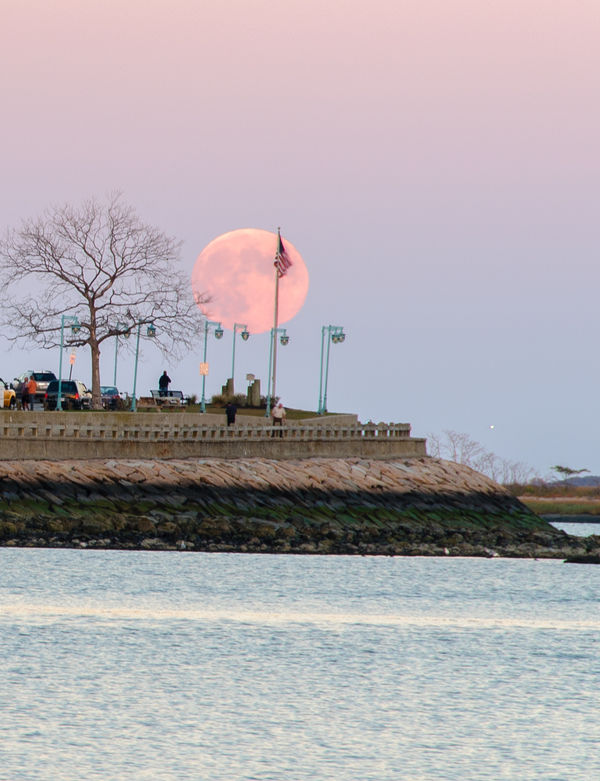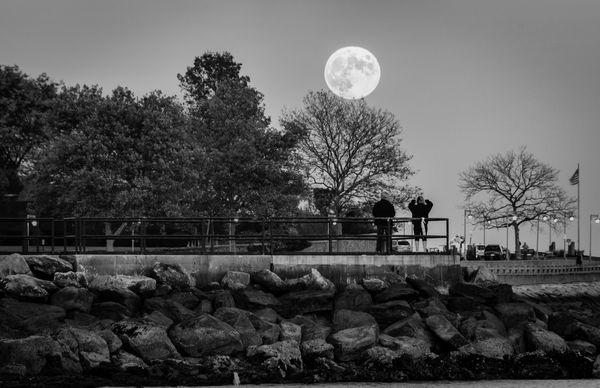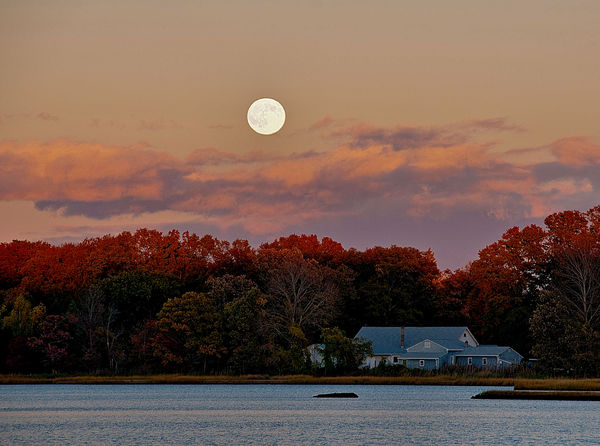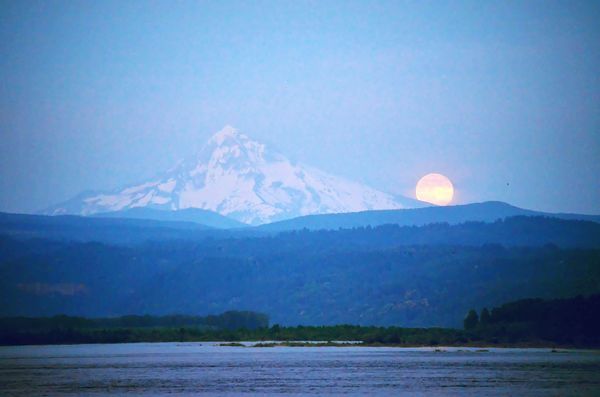Photographing the moon with landscape
Aug 2, 2014 19:45:06 #
Hi. With the second super moon of the season coming this next weekend, I would like to get some opinions on what it takes to get a good photo with it. Below is an example of what I accomplished last month. My equipment (which is not going to change in the near future) is a Nikon D5100 with two kit lenses (18mm-55mm & 55 mm-200mm). I also use a tripod and remote shutter button for this.
Last month, my hope for taking a pictures on the evening before the full moon was ruined by clouds, so it was the next evening (after the moon was truly full early that morning). By the time it rose from behind the mountain, about a half hour or so after sunset, the mountain was getting fairly dark. Because the moon moves fairly quickly, I tried keeping the shutter speed fast enough to keep the moon from blurring. With the aperture as wide open as possible (which was only f5.6 at the 155mm zoom), the ISO value had to be high enough to make the photo pretty noisy. I also tried using in camera HDR because the moon would be bright but the mountain would not be. That didn't seem to make any difference, partly because the moon isn't as bright as expected near the horizon. It also forced me to use jpg instead of raw.
This month, I hope to get out there a day or two ahead of the full moon, weather permitting, to capture the moon while the mountain is still sunlit. From this same location it looks like the moon will rise much higher on the mountain, which is ok. However, due to the increased elevation before it can appear, it won't show up until probably about 45 minutes after it's official moon rise time. (Moon rise is based on flat horizon) The mountain might be brighter, but the moon will be dimmer.
This time, I plan to allow somewhat slower shutter speeds (maybe 1/10s to 1/30s) so I might be able to keep the ISO value down. I also have a CPL and a UV filter. Are they or any other filters likely to help with these photos? What other suggestions does anyone have that I should try in order to improve the chances of getting a photo that is close to the best I can do with my setup? Are there any tricks to the trade that might help? The moon raises fairly quickly, so there is not a lot of time to think on the fly.
The one thing I know I can't do much about is the weather. This is the Pacific Northwest and hazy mountains with at least some clouds is not uncommon. Any tricks for the haze?
Thanks,
Jerry
Last month, my hope for taking a pictures on the evening before the full moon was ruined by clouds, so it was the next evening (after the moon was truly full early that morning). By the time it rose from behind the mountain, about a half hour or so after sunset, the mountain was getting fairly dark. Because the moon moves fairly quickly, I tried keeping the shutter speed fast enough to keep the moon from blurring. With the aperture as wide open as possible (which was only f5.6 at the 155mm zoom), the ISO value had to be high enough to make the photo pretty noisy. I also tried using in camera HDR because the moon would be bright but the mountain would not be. That didn't seem to make any difference, partly because the moon isn't as bright as expected near the horizon. It also forced me to use jpg instead of raw.
This month, I hope to get out there a day or two ahead of the full moon, weather permitting, to capture the moon while the mountain is still sunlit. From this same location it looks like the moon will rise much higher on the mountain, which is ok. However, due to the increased elevation before it can appear, it won't show up until probably about 45 minutes after it's official moon rise time. (Moon rise is based on flat horizon) The mountain might be brighter, but the moon will be dimmer.
This time, I plan to allow somewhat slower shutter speeds (maybe 1/10s to 1/30s) so I might be able to keep the ISO value down. I also have a CPL and a UV filter. Are they or any other filters likely to help with these photos? What other suggestions does anyone have that I should try in order to improve the chances of getting a photo that is close to the best I can do with my setup? Are there any tricks to the trade that might help? The moon raises fairly quickly, so there is not a lot of time to think on the fly.
The one thing I know I can't do much about is the weather. This is the Pacific Northwest and hazy mountains with at least some clouds is not uncommon. Any tricks for the haze?
Thanks,
Jerry
Aug 2, 2014 20:00:44 #
Erdos2 wrote:
Hi. With the second super moon of the season comin... (show quote)
Good question. Some of the professionals (or wannabes) on this forum suggest that instead of thinking about equipment, getting closer to the subject is the best approach....
:) :)
Aug 2, 2014 20:31:02 #
Peterff wrote:
Good question. Some of the professionals (or wannabes) on this forum suggest that instead of thinking about equipment, getting closer to the subject is the best approach....
:) :)
:) :)
Closer to the moon? I'd love to do that, but the mountain would be behind me back on earth. :-)
Just kidding. There are tradeoffs for getting closer to the mountain too. The relative sizes of the moon and mountain changes and I'd need to research potential locations along the lines of interest. Then there are all the trees in the way. This is Oregon... Closer is a possibility for further in the future.
Aug 2, 2014 20:41:09 #
jaygreen55
Loc: Westport CT
Hi
You might find these links helpful
http://www.photocentric.net/TIPS_%20PhotographingMoonriseMoonset.pdf
http://www.jeffsullivanphotography.com/blog/2013/09/17/how-to-predict-moon-rise-for-landscape-photography/
Photographing full moon rise has been one of my favorite subjects. Unfortunately living in the Northeast the weather is not always cooperative
A tripod and a good telephoto lens are important. Even with my 70-300 I end up cropping heavily
You might find these links helpful
http://www.photocentric.net/TIPS_%20PhotographingMoonriseMoonset.pdf
http://www.jeffsullivanphotography.com/blog/2013/09/17/how-to-predict-moon-rise-for-landscape-photography/
Photographing full moon rise has been one of my favorite subjects. Unfortunately living in the Northeast the weather is not always cooperative
A tripod and a good telephoto lens are important. Even with my 70-300 I end up cropping heavily
Black Rock Harbor CT 10-19-2013

(Download)
Black Rock Harbor Ct 10-19-2013

(Download)
Westport Ct 10-19--23-2010

(Download)
Aug 3, 2014 00:05:37 #
jaygreen55 wrote:
Hi
You might find these links helpful ....
You might find these links helpful ....
Nice photos. I will be quite pleased if any of mine in the future approach what you have accomplished.
Good links too. I had already found the Photographers Ephemeris software. It helped in figuring out where to be last month.
Aug 3, 2014 07:34:36 #
Erdos2 wrote:
Hi. With the second super moon of the season comin... (show quote)
Have you thought about doing two exposures? You can more easily capture better nightscape images if you expose longer for the landscape, then remove the white disk (moon overexposed), and replace it with a short exposure to get the moon right. I would use a shorter lens for the landscape, and a longer lens for the moon, and, using the landscape as your background image, place the moon in it and scale it as necessary to make it look "right."
Aug 3, 2014 09:05:39 #
Peterff wrote:
Good question. Some of the professionals (or wannabes) on this forum suggest that instead of thinking about equipment, getting closer to the subject is the best approach....
:) :)
:) :)
Walk on water to get closer to the moon? I did not know that. :oops: :oops:
Aug 3, 2014 09:52:07 #
I think your shot is stunning!
That you're trying to capture in a very specific location - which is probably only good for a couple of months since the moon changes location - and with only a few minutes' optimum light (in just a 2-day window) is pretty amazing.
Don't know of anything you can do about haze. I've gotten some decent moon rise (and moon set) shots in Yakima, but the air was dry. I just tried to bracket and shoot quickly :) Wasn't into raw then, but am now, so hoping for better this fall.
That you're trying to capture in a very specific location - which is probably only good for a couple of months since the moon changes location - and with only a few minutes' optimum light (in just a 2-day window) is pretty amazing.
Don't know of anything you can do about haze. I've gotten some decent moon rise (and moon set) shots in Yakima, but the air was dry. I just tried to bracket and shoot quickly :) Wasn't into raw then, but am now, so hoping for better this fall.
Aug 3, 2014 11:37:23 #
Aug 3, 2014 11:52:37 #
Erdos2 wrote:
Hi. With the second super moon of the season comin... (show quote)
Its a nice composition and some noise reduction would make it better.
Take a look at Noiseware Community Edition... its free.
Aug 4, 2014 15:45:32 #
joer wrote:
Its a nice composition and some noise reduction would make it better.
Take a look at Noiseware Community Edition... its free.
Take a look at Noiseware Community Edition... its free.
I installed Noiseware Community Edition and it can really do a good job on noise. See the image below. (It might be a little bit over processed, but it shows the improvement from noise reduction)
Between that and the other suggestions, I should be able to improve my shots during the full moon this coming weekend. (assuming the weather cooperates).
Thanks to all who commented.

Aug 11, 2014 18:54:29 #
For anyone looking at this in the future, below is the photo I captured the following month from the same location. This time, the photo was taken the evening before the full moon (about 15 hours before true full). Key settings were ISO 100, f20, 1/40th sec (well before sunset). The raw file was processed in Lightroom to help the lighting. Noise reduction is not an issue this time.
This month there are a number of forest fires in Oregon which added a layer of smoke to the horizon. Because of that, the photos when the moon was lower are not quite as pleasing. On the following evening the mountain was nearly totally invisible from Portland's Rocky Butte due to the smoke layer. That was a bummer for about 50 photographers and 300 others up there that evening.
This month there are a number of forest fires in Oregon which added a layer of smoke to the horizon. Because of that, the photos when the moon was lower are not quite as pleasing. On the following evening the mountain was nearly totally invisible from Portland's Rocky Butte due to the smoke layer. That was a bummer for about 50 photographers and 300 others up there that evening.

Aug 11, 2014 19:15:31 #
I love all the moon with landscape photos from everyone.
I need to win the Powerball and get some lenses, including something larger than my current 18-140mm.
I need to win the Powerball and get some lenses, including something larger than my current 18-140mm.
Aug 11, 2014 19:17:09 #
Erdos2 wrote:
For anyone looking at this in the future, below is... (show quote)
Nice. Not really relevant, but my first visit to the US was in November 1984. I was here for almost a month before I realized that you could see Mt. Hood from Beaverton. Something to do with rain and so on.
It did however, give me the inspiration to relocate to the US, and I'm now in San Francisco.
Your pictures are bring back memories, thank you!
And last night, I had San Francisco cloud / fog in the way. Grrr!
If you want to reply, then register here. Registration is free and your account is created instantly, so you can post right away.






